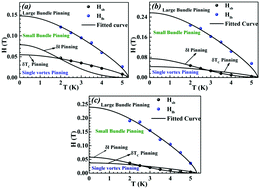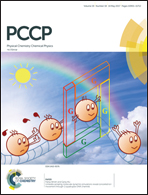Enhancement of superconducting critical current density by Fe impurity substitution in NbSe2 single crystals and the vortex pinning mechanism†
Abstract
Magnetization measurements have been used to determine the effect of magnetic impurities (Fe) on the Larkin–Ovchinnikov (LO) 3D collective pinning model in NbSe2 single crystals. Upon increasing the concentration of Fe impurities, the superconducting critical current density enhances appreciably compared to pure NbSe2 reflecting the fact that the addition of magnetic impurities assists in improving the practical applicability of NbSe2. The random pinning potential that is introduced by the Fe impurities also shows a considerable change in the interaction between the vortices and the core region, resulting in a competitive nature of single vortex, small bundle and large bundle pinning regimes in the H–T phase diagram. The intrinsic disorder in pure NbSe2 single crystals shows δTc flux pinning; however, the extrinsic disorder created by Fe atoms in NbSe2 shows δl flux pinning. Furthermore, the field dependence of the pinning force on both NbSe2 and Fe-incorporated NbSe2 represents the existence of point pinning and the surface pinning mechanism with a broadening of the fp curves in the Fe-incorporated single crystals.



 Please wait while we load your content...
Please wait while we load your content...